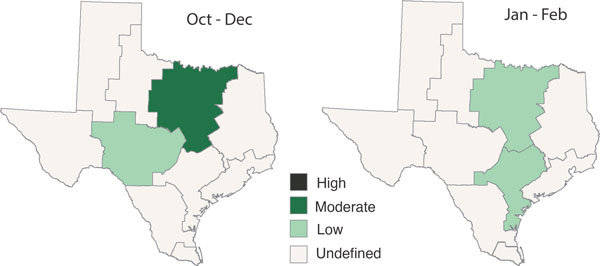The weather is warming, and wheat has started to green up across the state. With the onset of spring weather, it is time to look at factors that could influence the yield potential of the Kansas wheat crop. At K-State, we carefully watch regional stripe rust reports, particularly to our south. On March 6, Amir Ibrahim, Texas A&M AgriLife Research, reported stripe rust in a disease observation nursery in Castroville, TX where the disease is allowed to develop naturally. At the time of this publication, there have been no stripe rust observations in Oklahoma or Kansas.
Looking south helps predict stripe rust outbreaks in Kansas
There are several factors that contribute to the development and severity of stripe rust in our region. The stripe rust pathogen typically does not survive in Kansas over the winter but can survive in Texas through the winter months. Because of this, weather conditions in Texas in the fall and early spring can be important predictors of how bad stripe rust will be in Kansas.
A look at the moisture patterns for 2022-23 indicates there was some moisture in Texas in the fall (map on left in Figure 1) which may have been favorable for rust development. However, conditions have been dry through the early spring, which likely suppressed the early stages of disease development and spread. (map on right in Figure 2) What does that mean for us? We likely will have below-average levels of spores that arrive in Kansas during our critical growth stages, and a lower risk of severe yield losses to stripe rust this year. Remembering this is just a piece of the puzzle in determining risk is important. The severity of stripe rust in Kansas after it is first detected will largely be driven by local weather conditions and the varieties that are planted in the state. The disease situation can change rapidly, and it is important to continue to watch for signs of disease development as the season progresses.
Once stripe rust is detected in Kansas, cool evenings and extended periods of canopy moisture will be necessary for disease establishment at levels that would result in yield loss.
We will continue to provide updates on stripe rust occurrence and weather outlook as we move toward critical growth stages for fungicide applications in Kansas over the next several weeks.

Figure 1. K-State research has shown that the annual severity of stripe rust outbreaks in Kansas can be predicted by soil moisture in key regions of Texas in both the fall and the early spring. In 2022, soil moisture in Texas was low to moderate (indicated by light/medium green colors on the map). In the spring of 2023, there was low soil moisture in some of the key regions of Texas. These maps show soil moisture levels based on the “Palmer Z-Index” provided by NOAA-National Centers for Environmental Information.
Please contact us (andersenk@ksu.edu) if you detect stripe rust in Kansas so we can update regional maps.
Kelsey Andersen Onofre, Extension Plant Pathologist 785-410-2426 (m)
andersenk@ksu.edu
785-410-2426 (m)
Erick De Wolf, Plant Pathologist
dewolf1@ksu.edu
Tags: wheat disease stripe rust